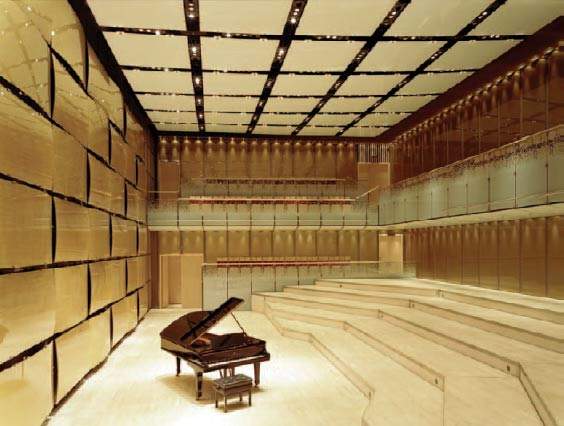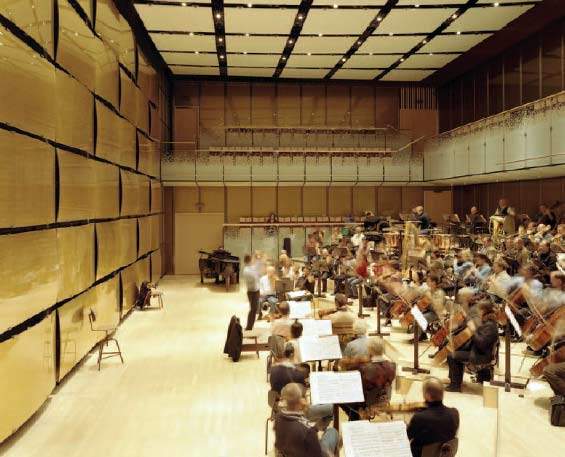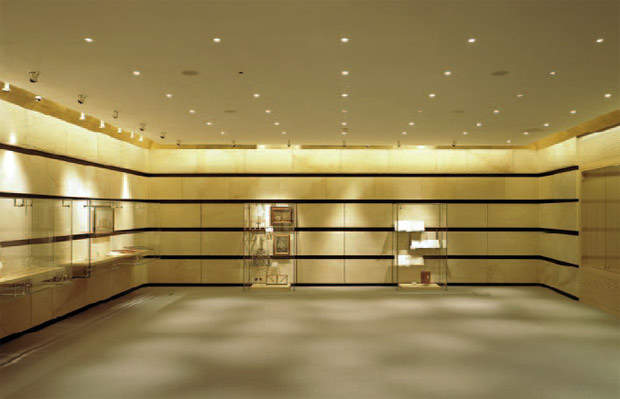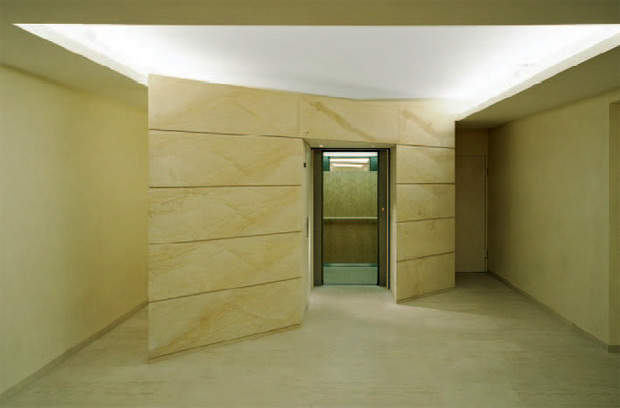The designing of four new music halls for Vienna’s legendary Musikverein was no easy task. James Leavey talks to architects Wilhelm Holzbauer and Dieter Irresberger about the challenges of living up to the Golden Hall’s legacy.
There is more to Vienna than meets the eye. Over the centuries, Austria’s capital has quietly expanded downwards, particularly in the city centre, where space is at a premium and modern developments are frowned upon.
UNDERGROUND EXPANSION
In April 2004, the most prestigious subterranean extension in Vienna’s recent history opened for business; four new music halls were inaugurated beneath the Ringstrasse-style Musikverein building, where the world-famous New Year’s Day Concert is
broadcast every year, performed by the resident Vienna Philharmonic Orchestra.
The Musikverein’s stunning Golden Hall, built between 1867 and 1870 by Theophil Hansen for the Society of Music Lovers, is considered by many to have the best acoustics in the world, and has been used as a model for countless new concert halls.
It was certainly a tough act to follow. The new Glass, Steel, Wood and Stone Halls, located under the square between the Musikverein and the Künstlerhaus, were designed by Austrian architects Wilhelm Holzbauer and Dieter Irresberger.
They were given a direct commission in 2001 because of their experience in building the Amsterdam Opera and the Festival Hall in Baden-Baden, as well as several other well-known music venues.
GLASS, STEEL, WOOD AND STONE ROOMS
The Glass Hall, the largest of the four rooms, seats 380 and is the centrepiece of the Musikverein’s new subterranean complex.
Glass is the dominant material and is used for the walls and the galleria parapets. Glass panels – both fixed and movable, lat and curved – are adorned with a layer of gold leaves on the reverse side and mounted on the ‘conductor’ wall.
Movable convex glass elements enlarge the absorbing surfaces at the press of a button, if required.
The Steel Room seats 70 and is used for workshops, experimental music and new scenic productions.
About 55% of the entire wall area is lined with four rows of sheet metal panels punctuated with holes according to acoustic requirements, allowing a change from slightly reverberant to studio atmosphere and providing a suitable environment for more
percussive ensembles.
The Wood Room seats 50 and is mainly used for lectures and press conferences. By opening a sliding door, it becomes part of the foyer area.
The Stone Room seats 60 and features both rough and polished stone surfaces. It is used mainly for exhibitions and showcases.
Acoustical features to disperse the uniformity of stonework include 8cm-wide, high-absorption cracks between the stone rows and forward-inclined steps, thereby avoiding total surface uniformity.
The carpeted floor suppresses plane parallel reflections, compensating the reverberant lower frequency portion.
A GLASS MUSIC ROOM
“Creating a room for music in glass was, I think, the most innovative aspect of the whole project,” says Holzbauer. “The Vienna Philharmonic Orchestra usually rehearses in the Golden Hall when it is empty, and there were always some problems
acoustically because the music sounded different when it was filled with people.”
“One of the prerequisites of the new Glass Hall was that it should, acoustically speaking, replicate the conditions in the Golden Hall when it is filled with people. The Glass Hall also had to be precisely the same size as the orchestral podium in the
Golden Hall, and it had to be suitable for functions like chamber concerts.”
To meet these demanding requirements, Holzbauer and Irresberger worked closely with the acoustic consultant, Karl Bernd Quiring. “The initial architectural concept ensured, as far as possible, that the acoustics would be very good,” says Holzbauer.
“Quiring then made some necessary corrections, such as the size of the panels.”
The result was a highly successful reinterpretation of the best features of the original building. “Instead of slavishly copying the original Musikverein design, we decided to take the one theme that is unique in the world,” explains Irresberger, “and
that is the Golden Hall. The other themes – wood, metal and stone – seemed to follow naturally.”
“Just before the first rehearsal in the Glass Hall, I had a bet with Quiring. He thought there might be some problems with the acoustics later on, but I said they were fine. After that first rehearsal with the Vienna Philharmonic Orchestra, the
musicians and the conductor said the acoustics were perfect. So I won the bet.”
This was a major achievement for all concerned. According to Irresberger, there are still concert halls being built with bad or inferior acoustics: “Just think of the Lincoln Center in New York, where the acoustics are still not ideal.”
“Even with all the latest technology, you still cannot be certain of the result.”
So, what’s their secret? “It’s partly experience,” ponders Irresberger, “partly a gut feeling for music and partly luck. I guess it helped that Holzbauer and I both love music. Although we are not specialists – we have created all sorts of
buildings – whenever we get the chance to design a room or building for musical performances, that is the one project we like best.”
FINDING THE PERFECT ACOUSTICS
When it comes to music, everything depends on the acoustics. So what were the ingredients needed to create perfect, or near perfect, acoustics in such a renowned venue?
“Basically, you need the right amount of sound absorption,” explains Quiring. “This depends on the position of sound absorbers in the music room, including the amount of reflecting surfaces, as well as the optimum sound distribution, which is heavily
influenced by the amount and quality of the sound diffusion of all the surfaces. That said, maximum sound diffusion is not the optimum solution.”
According to Quiring, the main challenge was working with the materials used for each of the four rooms. “I was also working in the environment of the Gold Hall, which is the best concert hall in the world,” he explains, “and the shape of each of the
halls seriously pushed the limits of acoustical possibility.”
“I was handling hard, reflecting surfaces, using their good properties and suppressing their bad properties, and exchanging the acoustical properties of the rooms to a certain extent – like exchanging reverberation for clarity. This meant I had
to develop new solutions that were not at that time found or documented in acoustical literature.”
MATERIAL CONCERNS
“The materials used in each room were given priority, and as the acoustician I had to measure the amount of absorption, diffusion and reflection. The major difficulty was overcoming the problems of using a variety of materials in each room. This was
done by applying a wide range of reliable acoustical measures, which could be adjusted to meet the requirements of whatever type of music was being played.”
Quiring’s excellent work on the acoustics for the Musikverein’s four new halls did not go unrecognised. Indeed, his efforts earned him a nomination for 2004’s Austrian Consulting Award, which was presented to his company in January 2005. Holzbaeur, Irresberger and Quiring, together with their gifted team of experts, have created a highly flexible extension of the greatest concert hall in the world.
The Musikverein rents out its various halls when they are not being used for the series
of concerts sponsored by the Society of Music Lovers.
Around 500 concerts are performed there every year – everything from modern commissioned works to small baroque chamber music ensembles. The four new music halls therefore provide valuable additional performance outlets for this in-demand
venue.







